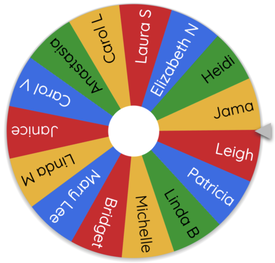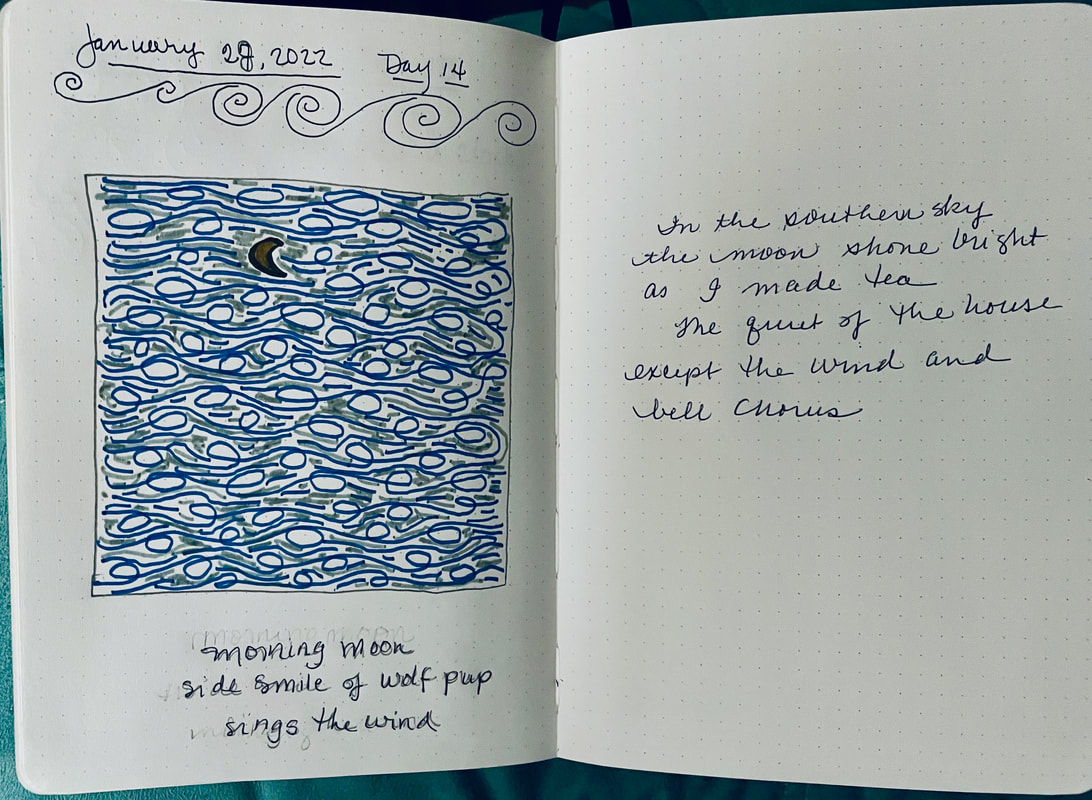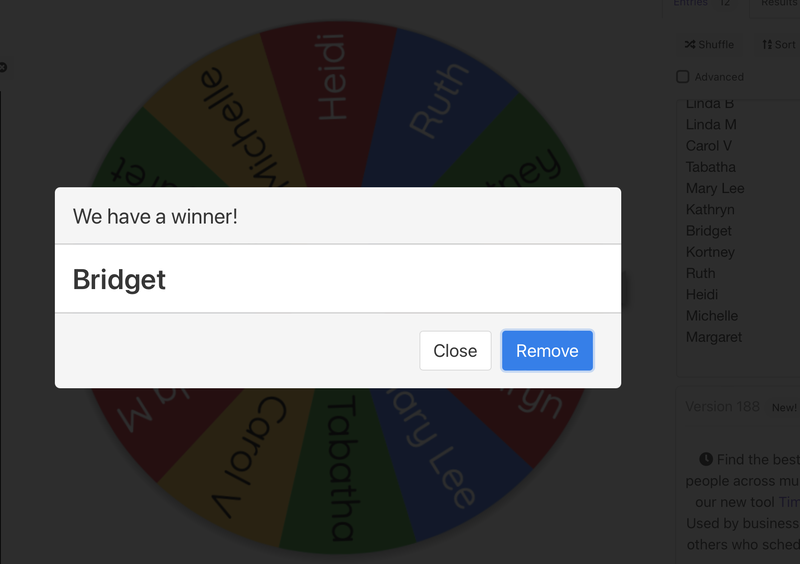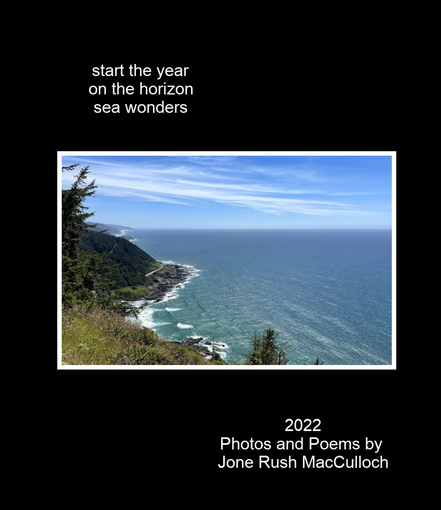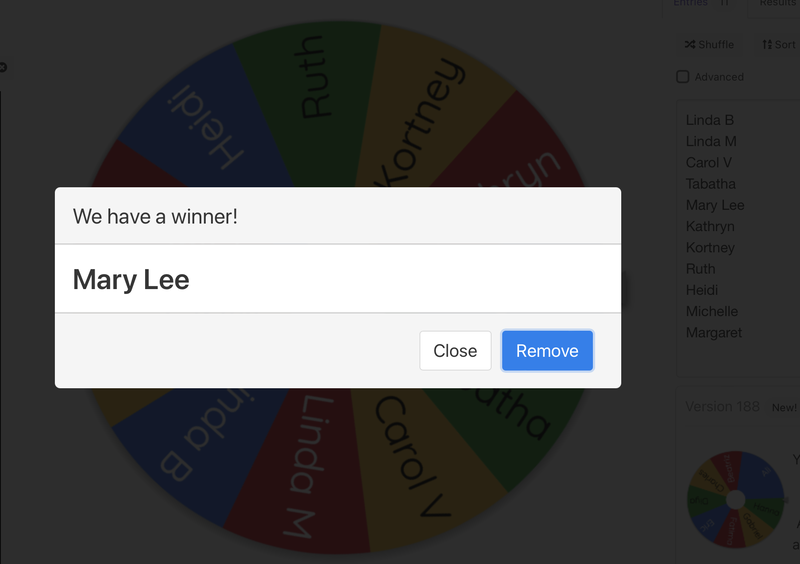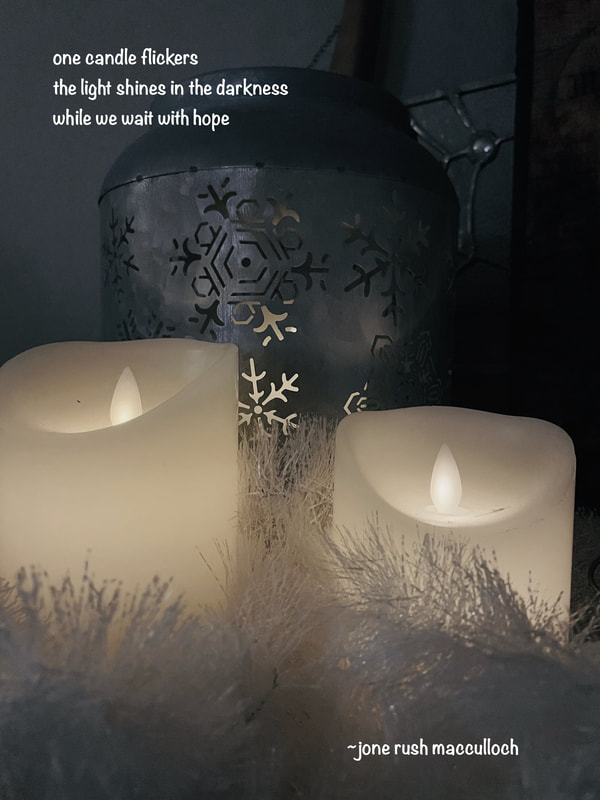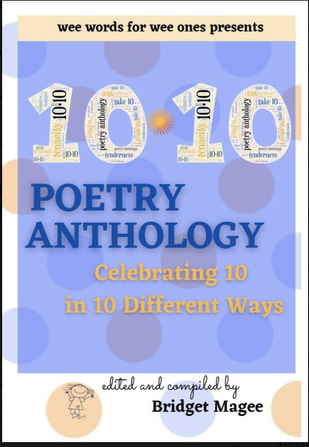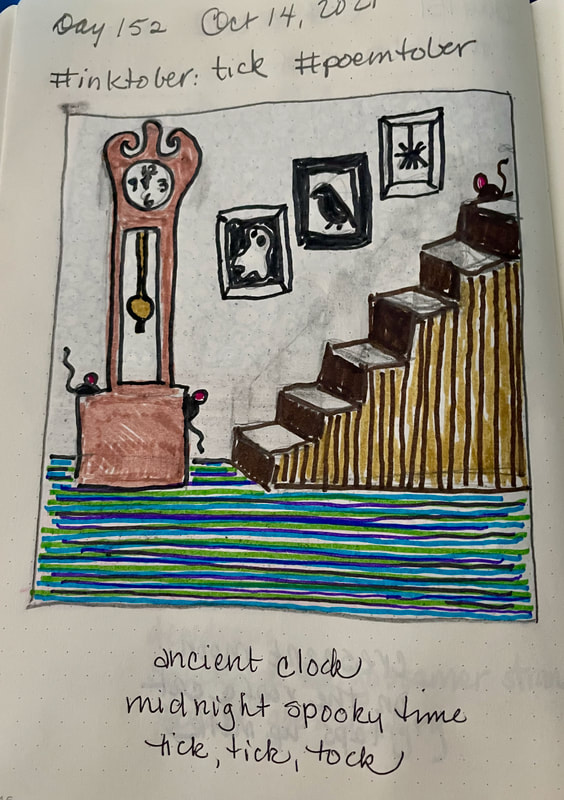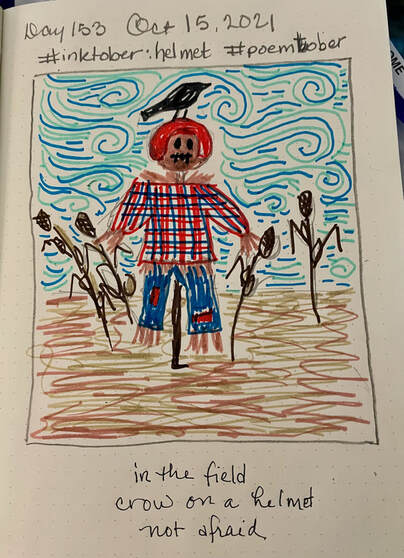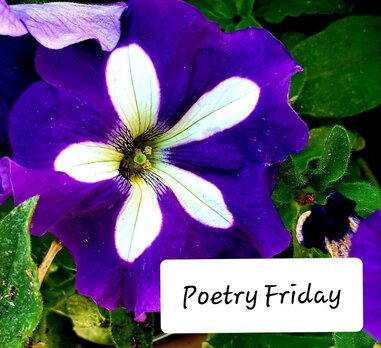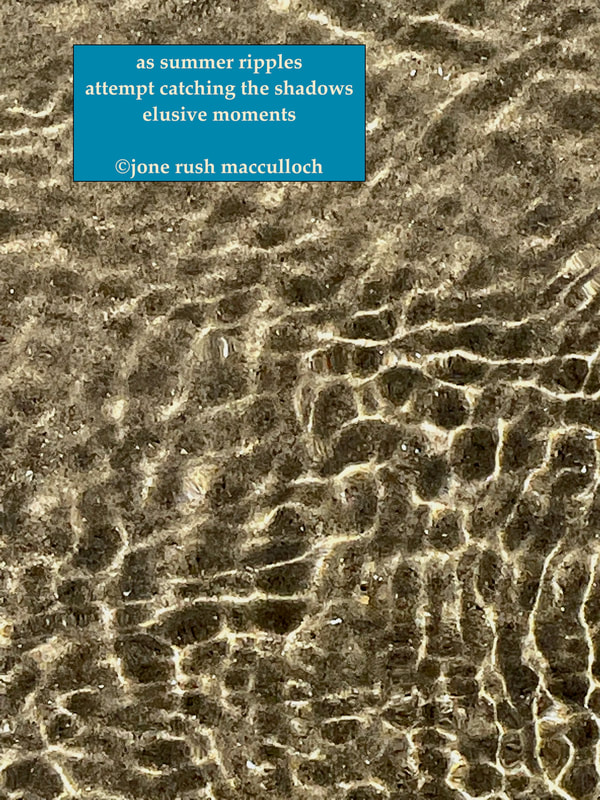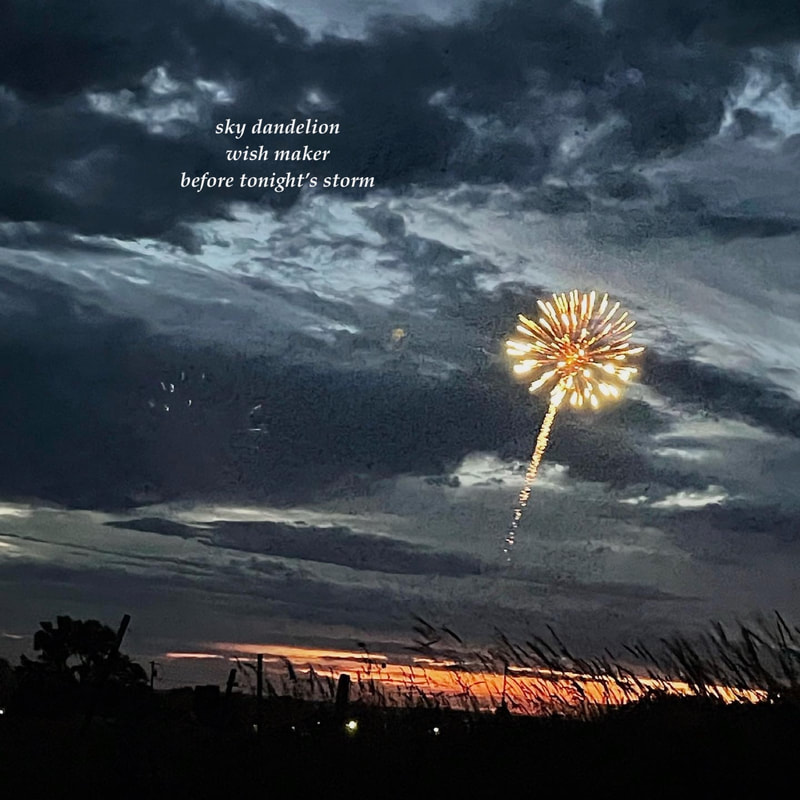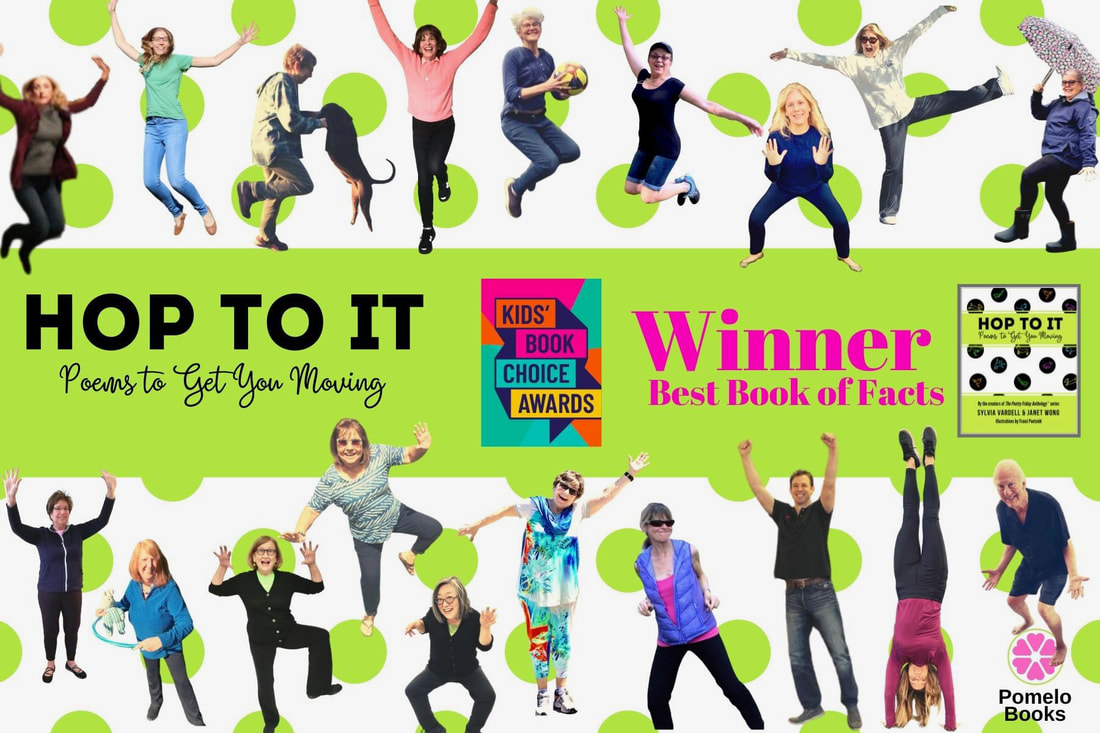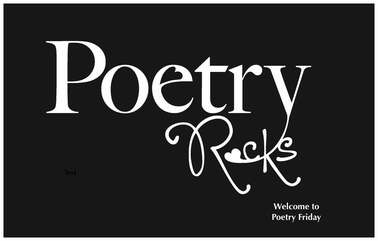 Graphic by Amber Fleek Graphic by Amber Fleek
Welcome to Poetry Friday. It's December? Just wow! Catherine at Reading to the Core is hosting us today.
I am writing a small poem every day in December. December 1 rainy day birds on the feeder fireside nap ©jone rush macculloch December 2 hammers pound inside my mouth root canal © jone rush macculloch (had not only a root canal this week but microsurgery in the mouth and it's been raucous ) The Poeming Pigeon Book Launch Part II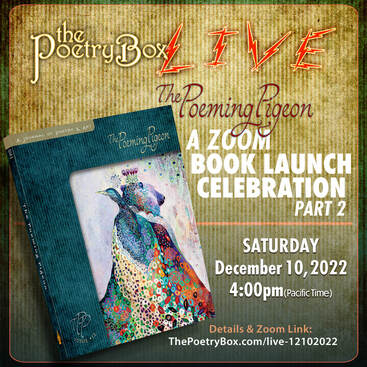
We have 12 poets reading and there will also be featured artwork from several artists in various slideshows. Featured Poets: Amelia Diaz Ettinger • Emmett Wheatfall • Leanne Grabel • Anne Richardson • Rebecca Smolen • Eileen McGurn • Jone Rush MacCulloch • Sue Fagalde Lick • M.F. McAuliffe • Dale Champlin • Ann Farley • Carter McKenzie Here’s the link for registration: https://us06web.zoom.us/meeting/register/tZItce6grj0uGtM9iv1mC4LkrDY19wNhS5bB (Once registered, you will receive a link from Zoom. Then on the day of the show, simply use the link that was sent to you to join about 5 minutes before the show starts so we can start on time). There will be a “waiting room” and Shawn will start admitting people in order of arrival a few minutes before the show. She'll review “zoom etiquette” with the audience after I welcome everyone, so they know how the show will proceed and how to use the chat room / speaker view / how to “applaud” / muting microphones during the reading, etc. I will also formally introduce each of you before you read. https://thepoetrybox.com/live-12102022 I am excited to be reading. 2023 New Year Poetry Postcard Sign Ups
Won't you join us? Sign up for the 2023 New Year Postcard Exchange. Send five, send ten or send to all. Did you know there are 30 days until 2022 ends? Woohoo! Let's celebrate the New Year with a New Year Postcard? In Japan, it’s called Nengajo, a Japanese custom of ushering in the new year.How It Works:
 PF graphic, ©Amber Fleek PF graphic, ©Amber Fleek Poetry Friday is hosted this week by Carol at Beyond LiteracyLink. Are you interested in a poetry challenge? The September #poetrypals challenge is the Definito, created by poet Heidi Mordhorst, 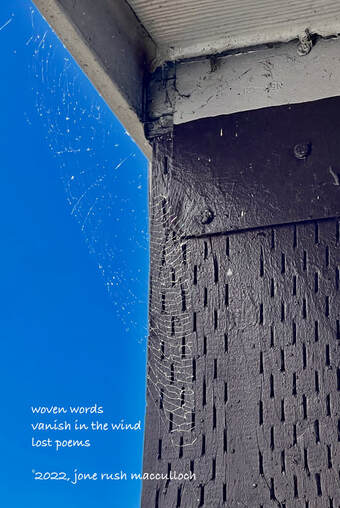 I wish I was better are responding to poetry opportunities and prompts. Today I found Margaret's photo prompt. A spider web. I love me a good spider web. This afternoon as I was enjoying the deck, I looked up (Isn't always about looking up?). A spider web. Thus I found my Poetry Friday entry for this week. woven words vanish in the wind lost poems ©2022, jone rush macculloch 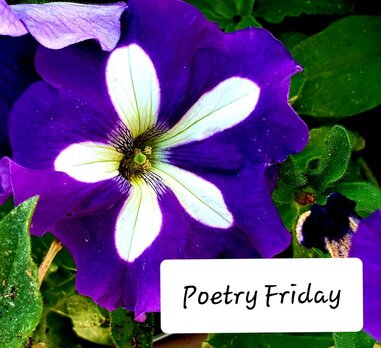 Matt at Radio, Rhythm & Rhyme has hosting duties this Poetry Friday. Matt has a terrific interview with Leslie Bulion. Here I have an interview with Sally Walker. Thanks to Mary Lee, I got in touch with Anne Irza-Leggat at Candlewick Press. She connected me with two poets for this month that have new books coming out in April. In the fall, I will be interviewing two more poets when their books arrive in the world. 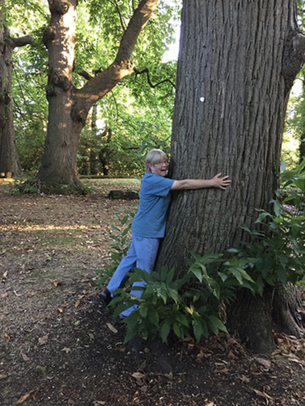 From Sally Walker's Website From Sally Walker's Website Meet Sally Walker. This picture tell me that she and I could be great friends as I love a good hug with a tree. from early readers to nature books STEM books, history and picture books, Sally has written so many. Earth Verse was her first book written in haiku. Her latest, Out of This World: Star-Studded Haiku, is as she says a "language spaceship" . Through haiku, readers will travel the universe. There's great back matter at the end of the book. Sally was gracious to answer questions I had for her. I loved learning about the diamonds that a certain planet has (read the interview to find out). 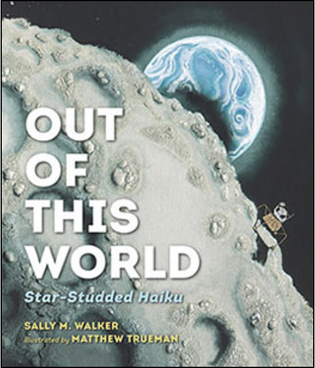 JRM: How did you get the idea for Out of This World: Star-Studded Haiku? What was your process for writing this book? SW: The idea began with a haiku that I wrote about Saturn: Rings of rock and dust/circle around Saturn’s waist/cosmic Hula-Hoops. It made me smile, as I remembered summer days spent playing with a Hula-Hoop. It became part of a manuscript with the working title Sci-ku. As I have done in many of my books, I wanted to create a book that would as a bridge to connect science with literature—one that combined facts and language play. Sci-ku’shaiku ranged from geology, to space, to physics, and to biology. I submitted the manuscript to Hilary Van Dusen, my editor at Candlewick. She liked the idea, but felt that the book would be more effective if all of the haiku immersed the reader in one particular scientific field. She was absolutely correct! I narrowed the focus to geology, my number one science love. The manuscript became Earth Verse: Haiku from the Ground Up. The haiku about Saturn ended up on the cutting room floor. Sadly, because I really liked that one. After completing Earth Verse, Hilary asked if I was working on anything else. I wasn’t, but suddenly the “cosmic Hula-Hoops” haiku popped back into my mind. My email reply to her suggested that I do a companion volume to Earth Verse that could be titled Out of This World: Star-studded Haiku. Of course I included the haiku about Saturn among those that I submitted in my formal proposal! Part of my process for writing Out of This World was paying attention to the stars, planets, and the moon as they appear to move across the sky as Earth rotates. Early morning, just before dawn, is my favorite time to be outside. Even on the coldest days, I go for a walk and look at the moon and the stars. Another part of my process was to look at the stellar—ha, ha, that pun was too good to resist—photos on the National Aeronautics and Space Administration’s (NASA) website, www.nasa.gov. It’s an awesome website where one can spend hours immersed in all kinds of space-related information. The photos are beyond belief!! JRM: I think one of the best parts about writing is doing research for a topic. What kind of research did you do for Out of This World? SW: Research is, hands down, my favorite part of being an author! An important part of writing this book, which later morphed into research, came from re-living experiences from my childhood. For example, I remember sitting in the backyard with my father on summer nights. He would point out different constellations—Orion and the Big Dipper are two vivid memories—and tell me stories about how they got their name. My family always watched lunar and solar eclipses. We always used the pinhole in cardboard way to view a solar eclipse safely. One Christmas, when I was about 10 years old, my cousin received a telescope as a gift. He invited us to his house one night so we could see Saturn’s rings. That blew me away! Maybe that’s how Galileo felt when he first saw them. In July 1969, half the people in our neighborhood crowded around the television in my family’s livingroom and watched the Eagle land on the moon. We all held our breath until it touched down and then cheered!! Reality TV at its absolute best!!! I researched scientific papers, books, old newspapers, and NASA’s website about all of these topics for additional information, as well as important updates, to material that I remembered from childhood. Interestingly, research that I’d done for other books gave me a lot of information for Out of This World. My research adventures for Boundaries, my book about the Mason-Dixon line, led to planetarium visits and lots of stargazing. Charles Mason and Jeremiah Dixon drew their famous line of latitude guided by the position of stars. My husband, a volcanologist, was happy to talk with me about the Martian volcano Olympus Mons, the largest volcano in our solar system. In college, when I majored in geology, I learned that scientists theorize that an asteroid strike 65 million years ago likely led to the extinction of dinosaurs on Earth. It seemed natural for me to write a haiku about that. JRM: What was the most surprising discovery you had in writing this book? SW: Good question! One discovery that I knew absolutely NOTHING about was that it rains diamonds on the planet Uranus. That planet, one of our solar system’s four planets that have no solid land surface, has a slushy plasma ocean that surrounds the planet’s solid core. The pressure within the ocean forces carbon atoms to crystallize as diamonds. Because the diamonds are heavier than the surrounding “slush,” they rain downward, toward the core. This discovery also led to a funny research story. When Matthew Trueman was creating the illustration for the haiku diamonds rain, unseen/in a slushy plasma sea/sunken treasure trove, he asked what color the sea was likely to be. I had NO idea. So, I did some research. I emailed Dr. Dirk Gericke and asked him. He is a professor at the Centre for Fusion, Space & Astrophysics, in the Department of Physics, at the University of Warwick, in the United Kingdom. Dr. Gericke has written several papers on Uranus’s plasma sea. He helped me tweak the haiku so it was accurate, but he also consulted with his colleagues about the color of the plasma ocean. While no one can actually see it, their consensus (based on the chemical composition) is that the sea is bluish. I passed this information along to Matthew! JRM: What led you to write this book in haiku? How do you decide if you want to write in prose or haiku? SW: It was always intended to be a combination of haiku and nonfiction prose. My favorite haiku are those that not only make me think or feel about something, but also make me want to discover something new about the “moment” that I encountered while reading a particular haiku. I hope that the haiku in Out of This World will make readers think and ask questions. The narrative section of the book, hopefully, provides answers to some of those questions. Haiku is pretty much the only kind of poetry that I write. But I did not always enjoy it. I remember being taught about haiku in fourth grade. The teacher explained what it was: a short poem that did not rhyme, had only seventeen syllables, and revealed a profound, seasonal moment in nature. We didn’t talk about Japanese culture at all. Nor did we discuss how “less” can actually be “more.” She just read us a few haiku written by Basho and Issa. Sadly, I was too young to appreciate them—at least the ones she read to us. They made me feel “itchy” because I didn’t understand what they were about. When she asked us to write haiku, I felt like I was being asked to write something so profound that it was incomprehensible. Forcing the incomprehensible into a seventeen-syllable, non-rhyming poem made the assignment essentially impossible for me. Now, as an adult, I read a haiku like Basho’s The Old Pond (An old silent pond/a frog jumps into the pond--/Splash! Silence again.) and marvel at it. But the nine-year-old me wouldn’t have understood and appreciated all it encompasses. I would not have savored that exquisite last moment. I would have splashed into the pond and caught the frog. Today’s young readers meet haiku through the mastery of poets such as Paul Janeczko, Janet Wong, and J. Patrick Lewis. Children easily relate to their poems. They meet the reader in a place or moment that she or he can understand. A park bench, a curbside puddle, a beloved pet. That is incredibly powerful and freeing. Modern haiku poets often step outside the traditional guidelines of including a seasonal reference. And they frequently inject humor. Many of the haiku in Earth Verse and Out of This World explore moments in nature, but they are moments that exist for eons. I remember one of my geology professors telling us that in the timeline of life on Earth, humans have existed in the length of time that it takes to light a match and immediately blow it out. The formation of stars, land surfaces being eroded by glaciers and wind, an asteroid that wipes out millions of years of dinosaur existence are natural, cosmic “moments.” They exist on a timeline, the length of which we can scarcely comprehend. Why not write haiku about them? Although some poets write haiku that don’t strictly adhere to the seventeen-syllable format, I choose to do so. I like the challenge of seeking the perfect combination of words to convey an idea or impression in exactly seventeen syllables. It’s a game with language that lets me play with words, something I love to do. It requires lots and lots and lots of mental revision to get the syllable count for each line correct. That’s cool too, because many of the haiku that I write finally reach their “Eureka!” word-choice completion while I am outside walking and appreciating nature! JRM: What are your upcoming projects? SW: My next book is UNDERGROUND FIRE: HOPE, SACRIFICE, AND COURAGE IN THE CHERRY MINE DISASTER. The 1909 Cherry Mine fire is one of the worst coal mine disasters in United States’ history. My home is only 50 miles from Cherry, Illinois, and the story is one that I have wanted to bring to young readers for some years. It’s especially timely, given that it’s a story of immigrants and fossil fuel, both of which figure prominently in the news today. The publication date is October 2022. I do have another haiku book in the pipeline, scheduled for publication in Spring 2023. At the moment the title is TREES: HAIKU FROM ROOTS TO LEAVES. It's a bit early to share much more about it, but I can say that the illustrations are wonderful! Both books are with Candlewick Press. BONUS I: In another email, Sally and I shared an exchange about writing haiku for adults as well as the haiku structure. She shared this haiku Language meanders, words channeled into patterns. Poetic rivers BONUS II: Regarding haiku versus senryu Sally shared this little fact, I enjoy senryu a lot. In fact, I had to avoid producing them when I wrote Earth Verse and Out of This World. Thank you so much, Sally!
|
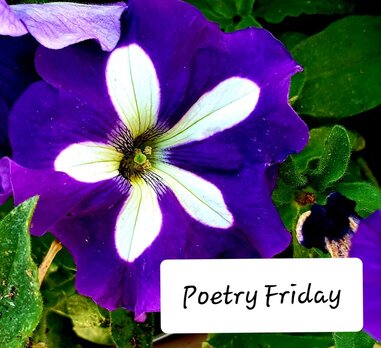 Bridget at wee words for wee ones is hosting today. I am looking forward to her new anthology, 10•10 Poetry Anthology: Celebrating 10 in 10 Different Ways. |
ancient clock
midnight spooky time
tick, tick, tock
Day 15: helmet
in the field
crow on a helmet
not afraid
©Jone Rush MacCulloch

And she has a gorgeous autumn poem. I love this line: "how time eats daylight." It's a great mystery.
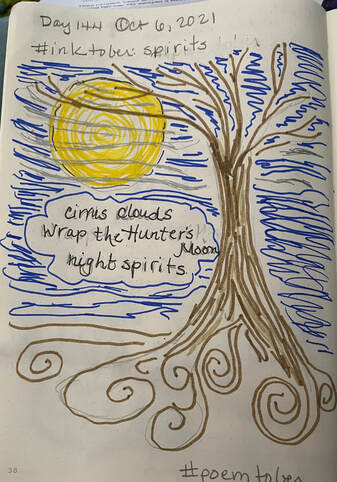
wrap the Hunter's Moon
night spirits
©Jone Rush MacCulloch
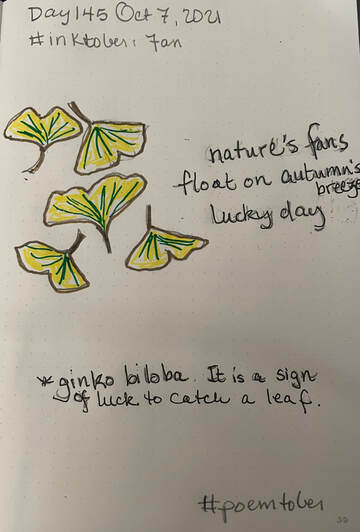
float on autumn's breeze
lucky day
©Jone Rush MacCulloch
*ginko biloba
It is a sign of luck to catch a leaf as it falls.
Today Catherine at Reading to the Core is hosting the Poetry Friday community. This month the Inklings Poetry Group are writing were challenged by Mary Lee Hahn to explain a poetry term (simile, metaphor, allegory, allusion, etc) in a poem that makes use of that term. OR tell how to write a poetry form (ode, elegy, sonnet, limerick, etc) in that form. |
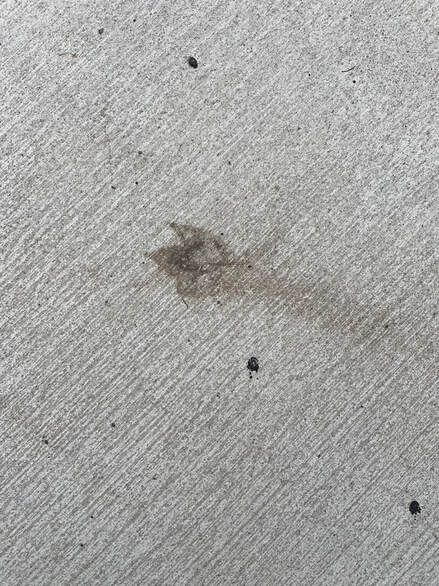
I am playing with two versions.
leaf shadow
after the rain
memory
©Jone Rush MacCulloch
memory
after the rain
leaf shadow
©Jone Rush MacCulloch
crystal stars
shimmer on the lake
wish makers
©Jone Rush MacCulloch
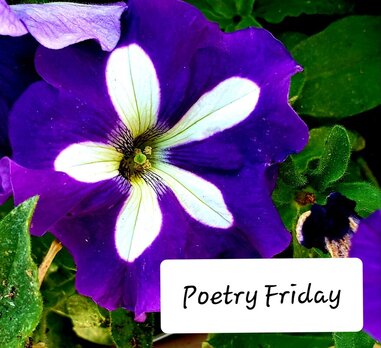

BTW, #poetryeverywhere is from a Naomi Shihab Nye quote, "See poetry everywhere."
Author
All photos and poems in these blog posts are copyrighted to Jone Rush MacCulloch 2006- Present. Please do not copy, reprint or reproduce without written permission from me.
Categories
All
#2021NaPoWriMo
2021 National Poetry Month
#2021NPM
2021 Progressive Poem
2022
2022 National Poetry Month
2022 Progressive Poem
2023 National Poetry Month
2023 Progressive Poem
2024 National Poetry Month
2024 Progressive Poem
Allan Wolf
Amy Ludwig Vanderwater
Amy Souza
Anastasia Suen
Animals
Aquarium
Art
Astoria
Aurora Borealis
Author Interviews
Author Lisa Fipps
Autumn
Awards
Bees
Bells
Betsy Fanco
Birds
Black History Month
Book Give Away
Book Quotes
Books
Bridges
Bridget Magee
Brú Na Bóinne
Buffy Silverman
B & W
Calendar
California
Candlwick
Cape Perpetua
Carnivorous Plants
Carol Labuzetta
Carrie Fountain
Cascade Poem
Catherine
Celtic New Year
Cento
Charles R Smith
Charles Waters
Childhood
Chris Baron
Classic Found Poetry Palooza
Clouds
Coast
Collage
Colors
Columbia Gorge
Cosmos
Curious
Current Events
CYBILS
David Elliott
Debut Book
Denise Krebs
Dodoitsu
Earth Day
Edgar Allan Poe
Ekphrastic
Ekphrastic Poetry
Ekphratic Poetry
Elfchen
Erasure Poetry
Exphrastic Poetry
Family
#februllage2022
Fernanda Valentino
Ferns
Fibonacci
First Drafts
Flowers
Flowers]
Folk Tale Week
Food
#foundhearts
Found Poems
Free Verse
Fundraiser
Garden
Gardens
Georgia Heard
Ghost Towns
Ginko
Giveaway
Goals
Golden Shovel
#gratiku
Growth
Haiga
Haiku
#haiku
#haikudiary
Halloween
Heart
Heidi Mordhorst
Helen Frost
Hope
HOP TO IT
IBBY
Ice
Imperfect II
#Inktober
Interviews
Invitation
Ireland
Irene Latham
Izchak Perlman
Jama Alphabet Soup
Janet Clare Fagal
Janet Wong
January 2023
Joanne Fritz
Joanne Rossmassler Fritz
Johanna Wright
John O Donohue
Joyce Sidman
Joy Harjo
Jr.
Kat Apel
Koi
Laura Purdie Salas
Laura Shovan
Leaves
Lee Bennett Hopkins
Light
Linda Baie
Linda Mitchell
Lita Judge
Liz Garton Scanlon
Love
Mandalas
Marcie Finchum Atkins
Margaret Simon
Marilyn Singer
Mary Lee Hahn
Memorial Day
Michelle Barnes
Michelle Kogan
Mixed Media
Moe Phillips
Monday Musing
Moon
Morning
Morse Code
Mud Puddle
Mystery
Naomi Shihab Nye
National Arbor Day
National Poetry Month
Native Plants
Natural World
New Book
New Growth
New Year Postcards
Notebooks
Ocean
Oddities
Odell
OLW
One Little Word
OR
Oregon Writers' Colony
Original Art
Pacific Northwest
Packard Group National Exhibition
Painting
Pamela Sue Johnson
Pandemic
Pantoum
Pat Mora
Patricia J Franz
Patterns
Paul B. Janeczko
Peace
Peonies
Photography
Plants
#Poemtober
Poetry
Poetry Challenge
Poetry Challenges
#poetrycommunity
Poetry Friday
Poetry Friday
#poetrypals
Poetry Play
#poetryplayground
Poetry Prompts
Poetry Share
Poetry Videos
Pollinators
Pomelo Books
Portland Japanese Garden
PreK
Process
Progressive Poem
Prose And Poetry
Publishing News
Queen Anne's Lace
Rain
Rainbows
Randi Soenshine
Rebecca Brock
Rebecca Herzog
Rebecca Kai Doltish
Rebecca Kai Dotlich
Recipe Poems
Redwoods National And State Parks
Reflcetions
Renewal
Reunion
Reverso
Revising
Revision
Rivers
Robert Burns Day
Robert R. Sanders
Robyn Hood Black
Rocks
Rose Cappelli
Sally Walker
Sarah Grace Tuttle
Scotland
Scottish Gaelic
#sealeychallenge
Sean Taylor
Shadorma
Shadows
Shawn Aveningo Sanders
Signs
Sky
#smallpoemsdecember
#smallpoemsjanuary
Snow
Snowman
Snowmen
South Carolina
Spark
Spiritual Journey Thursday
Spiritual Thursday
#SpookySpectacularFoundPoems
Spooky Spectacular Found Poems
Sports
Spring
Spring Snow
St Brighid's Cross
St. Brigid
#StopAsianHate
Students
Student Work
Summer
Summer Poetry Swap
Summer Solstice
Sunday Solace
Sunrise
Sunset
Super Bowl Sunday
Sylvia Vardell
Tabatha Yeatts
Tanka
Taylor Mali
Teaching Poetry
Texas Womens University
The Hill Of Tara
#theinklings
The Last Bookstore
The Poeming Pigeon
The Poetry Box
The Poet's Studio
The Sealey Challenge
This Poem Is A Nest\
Tracks
Trees
Tritina
Tualatin Wildlife Refuge
TWU Student Work
Ukraine
Universe
USBBY
Verse Of Ages
Veterans
Veteran's Day
Vietnam
Virtual Exhibit
Visual Haiku
Water
William Stafford
Winners
Winter
Winter Poetry Swap
Winter Solstice
WIP
Wnter
Word;less Wednesday
Wordless Wednesday
Wordy 30
Worm Moon
Yosemite National Park
Archives
July 2024
June 2024
May 2024
April 2024
March 2024
February 2024
January 2024
December 2023
November 2023
October 2023
September 2023
August 2023
July 2023
June 2023
May 2023
April 2023
March 2023
February 2023
January 2023
December 2022
November 2022
October 2022
September 2022
August 2022
July 2022
June 2022
May 2022
April 2022
March 2022
February 2022
January 2022
December 2021
November 2021
October 2021
September 2021
August 2021
July 2021
June 2021
May 2021
April 2021
March 2021
February 2021
January 2021
December 2020
November 2020
October 2020
September 2020
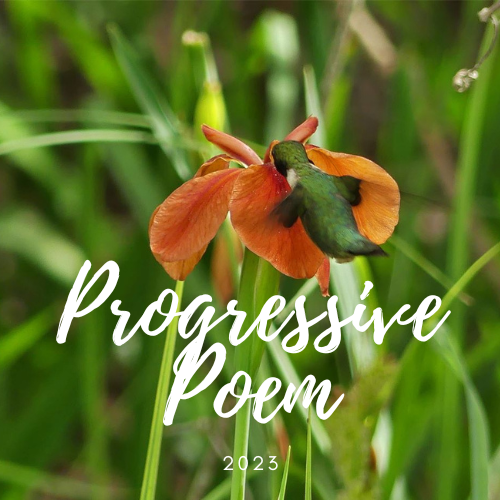
April 1 Mary Lee Hahn, Another Year of Reading
April 2 Heidi Mordhorst, My Juicy Little Universe
April 3 Tabatha, The Opposite of Indifference
April 4 Buffy Silverman
April 5 Rose Cappelli, Imagine the Possibilities
April 6 Donna Smith, Mainely Write
April 7 Margaret Simon, Reflections on the Teche
April 8 Leigh Anne, A Day in the Life
April 9 Linda Mitchell, A Word Edgewise
April 10 Denise Krebs, Dare to Care
April 11 Emma Roller, Penguins and Poems
April 12 Dave Roller, Leap Of Dave
April 13 Irene Latham Live You Poem
April 14 Janice Scully, Salt City Verse
April 15 Jone Rush MacCulloch
April 16 Linda Baie, TeacherDance
April 17 Carol Varsalona, Beyond Literacy Link
April 18 Marcie Atkins
April 19 Carol Labuzzetta at The Apples in My Orchard
April 20 Cathy Hutter, Poeturescapes
April 21 Sarah Grace Tuttle, Sarah Grace Tuttle’s Blog,
April 22 Marilyn Garcia
April 23 Catherine, Reading to the Core
April 24 Janet Fagal, hosted by Tabatha, The Opposite of Indifference
April 25 Ruth, There is no Such Thing as a God-Forsaken Town
April 26 Patricia J. Franz, Reverie
April 27 Theresa Gaughan, Theresa’s Teaching Tidbits
April 28 Karin Fisher-Golton, Still in Awe Blog
April 29 Karen Eastlund, Karen’s Got a Blog
April 30 Michelle Kogan Illustration, Painting, and Writing
